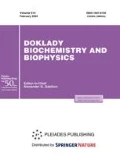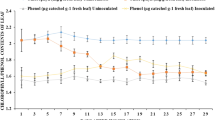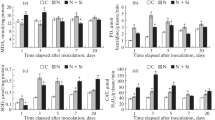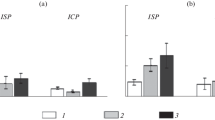Abstract
A study of the processes of lipid peroxidation and the activity of the peroxidase enzyme, as well as photosynthetic pigments in susceptible tomato plants treated with salicylic acid (SA), during infection with the root-knot nematode Meloidogyneincognita. It was shown that, in the roots of SA-treated plants, the activity of lipid peroxidation is higher compared to the untreated plants, especially in the case of nematode invasion. A significant increase in the activity of lipid peroxidation in SA-treated invasive plants compared with untreated was noted during the transition of larvae to the sedentary stage and the beginning of the formation of feeding areas—giant cells (3–5 days after invasion). This, apparently, contributes to the inhibition of the development of the parasite and the reduction of plant infection and also indicates the involvement of oxidative processes in the mechanism of the induced resistance of plants to root-knot nematodes. In the SA-treated plants, the qualitative and quantitative composition of photosynthetic pigments, disturbed by invasion, was restored and corresponded to the control level.


Similar content being viewed by others
REFERENCES
Decraemer, W. and Hunt, D.J., Structure and Classification in Plant Nematology, 2nd ed., Perry, R.N. and Moens, M., Eds., Wallingford, Oxfordshire: CAB International, 2013, pp. 3–29.
Melillo, M.T., Leonetti, P., Bongiovanni, M., et al., New Phytol., 2006, vol. 170, pp. 501–512.
Melillo, M.T., Leonetti, P., Leone, A., et al., Eur. J. Plant Pathol., 2011, vol. 130, pp. 489–502. https://doi.org/10.1007/s10658-011-9768-4
Kozel, N.V. and Shalygo, N.V., Russ. J. Plant Physiol., 2009, vol. 56, no. 3, pp. 316–322.
Desikan, R., Mackerness, S.A.-H., Hancock, J.T., and Steven, J., Plant Physiol., 2001, vol. 127, pp. 159–172. https://doi.org/10.1104/pp.127.1.159
Herrera-Vásquez, A., Salinas, P., and Holuigue, L., Front. Plant. Sci., 2015, vol. 6, p. 171. https://doi.org/10.3389/fpls.2015.00171
Zurbriggen, M.D., Carrillo, N., and Hajirezaei, M.-R., Plant Signal. Behav., 2010, vol. 5, pp. 393–396. https://doi.org/10.4161/psb.5.4.10793
Nazar, R., Iqbal, N., Syeed, S., et al., J. Plant. Physiol., 2011, vol. 168, pp. 807–815. https://doi.org/10.1016/j.jplph.2010.11.001
Zinovieva, S.V., Udalova, Zh.V., Vasyukova, N.I., et al., Biol. Bull. (Moscow), 2011, vol. 38, no. 5, pp. 453–458.
Kuznetsov, Vl.V., Kuznetsov, V.V., and Romanov, G.A., Molekulyarno-geneticheskie i biokhimicheskie metody v sovremennoi biologii rastenii (Molecular Genetic and Biochemical Methods in Modern Plant Biology), Moscow: BINOM, Laboratoriya Znanii, 2012.
Lichtenthaler, H.K., Methods Enzymol., 1987, vol. 148, pp. 350–382. https://doi.org/10.1016/0076-6879(87)48036-1
Gillet, F.X., Bournaud, C., Antonino de Souza, J.D., Jr., et al., Ann. Bot., 2017, vol. 119, no. 5, pp. 775–789. https://doi.org/10.1093/aob/mcw260
Zacheo, G., Bleve-Zacheo, T., and Pricolo, G., Nematol. Medit., 1987, vol. 15, pp. 293–302.
Wada, M., Plant Sci., 2013, vol. 210, pp. 177–182. https://doi.org/10.1016/j.plantsci.2013.05.016
Lavrova, V.V., Zinovieva, S.V., Udalova, Zh.V., et al., Dokl. Biochem. Biophys., 2017, vol. 476, pp. 306–309.
Author information
Authors and Affiliations
Corresponding authors
Ethics declarations
The authors declare that they have no conflict of interest. This article does not contain any studies involving animals or human participants performed by any of the authors.
Additional information
Translated by M. Batrukova
Rights and permissions
About this article
Cite this article
Udalova, Z.V., Zinovieva, S.V. Effect of Salicylic Acid on the Oxidative and Photosynthetic Processes in Tomato Plants at Invasion with Root-Knot Nematode Meloidogyne incognita (Kofoid Et White, 1919) Chitwood, 1949. Dokl Biochem Biophys 488, 350–353 (2019). https://doi.org/10.1134/S160767291905017X
Received:
Published:
Issue Date:
DOI: https://doi.org/10.1134/S160767291905017X




